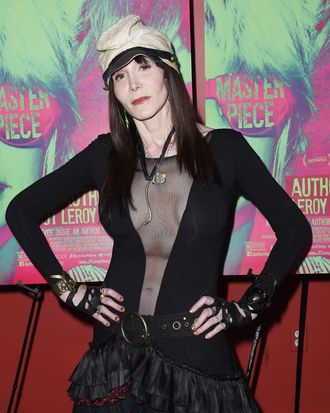
You may recall the scandalous story of JT LeRoy, the literary “It” boy whose works, the national bestsellers Sarah and The Heart Is Deceitful Above All Things, featured an HIV-positive male teen pimped out at truck stops by his prostitute mother. In the late ‘90s, 21-year-old LeRoy documented these purported personal struggles while cultivating a persona of shyness, at first refusing to appear in public at all. His fame grew to include a cult of celebrity confidantes in person — Winona Ryder, Bono, Courtney Love — until the truth came out.
In a 2005 New York Magazine feature, writer Stephen Beachy unmasked LeRoy as a fictional creation by a much older woman, wife, and mother named Laura Albert in what some consider one of the greatest hoaxes of modern-day literature. The person celebrities had met was Albert’s sister-in-law, who posed as JT LeRoy behind sunglasses and a wig.
Years after the scandal, Albert now stars in Jeff Feuerzeig’s new documentary, Author: The JT LeRoy Story, which hits theaters September 9. (It screened at Sundance.) The film traces Albert’s elaborate ruse and painful truths from her real life, including sexual abuse she survived as a child and a group home where she lived as a teen. Albert grew up as a ward of the state, skipping school while showing a talent for writing that took her to the New School, where she confronted the question: When you write, are you a woman or a man?
Albert told the Cut her side of the story at a New York screening on Wednesday, tracing the genesis of JT LeRoy to now. She started with her writing at the New School:
I unfortunately didn’t make it through, because I had a teacher who insisted that girls write as girls and boys write as boys. You couldn’t use a different-gendered voice, and that was too traumatic for me. I ended up writing about sexual abuse and having to go to a hospital, because I was getting too closed in, and I felt disgusting writing that stuff. I was, like, “Please, let me write as a boy, you don’t understand. I was calling hotlines all the time as a boy.”
It wasn’t until I started writing that it started coming together, like it heals. I could make hotline calls, they would never satisfy it, but when I was writing it, it mended something.
Writing as a boy called JT LeRoy, Albert said, was like using “asbestos gloves” to process material she couldn’t touch otherwise. “I had no words to express how I felt sexually,” she said. “I had so much shame, the level of shame when you feel damaged.” Then she thought of JT LeRoy:
In the ‘70s, when they were just starting to talk about running away and sexual abuse, there was always a cute blonde-haired, blue-eyed little boy, and I felt if I could be a blonde-haired, blue-eyed little boy, I would get help. And I also saw on the street, if I could have a gay man love me as a blonde-haired, blue-eyed boy, that is everything. I wanted to be a twink that was protected by a man; that’s what I wanted. Not even to look like Brooke Shields, but to be that. And I disassociated, and I wish I could have done it in my own skin.
She still doesn’t consider the scandal a hoax. “I understand people feeling hurt, and people gave me time, and if they feel I stole their time, all I can say is when JT felt suicidal, that was real for me,” she said. “That was real, and they saved my life. It was never a joke for me, and I don’t take it for granted.”
After the truth came out, Albert said she was approached by many people in Hollywood to tell her story. She refused to participate in a 2014 documentary, but when director Jeff Feuerzeig reached out, it was different. “I understood that he was interested not in telling a celebrity story, but available to a deeper truth, whatever that might be,” she said.
Feuerzeig said he wasn’t familiar with the JT LeRoy story when a friend suggested it might make an interesting film project. “I love ‘truth is stranger than fiction’ stories,” he said. He read up on the case and found it fascinating but felt there was more to the story, so he reached out to Albert. “I sent her my film The Devil and Daniel Johnson, which deals vividly with the intersection of madness and creativity, and the film really spoke to her.” He thinks the film raises questions about where fiction comes from, and even how to define it at all. “It was challenging,” Feuerzeig said of making the film. “It was also fun and rewarding to be inside this mind where, once again, madness and creativity intersected.”
Albert said she can now talk, as herself, to readers healing from their own trauma. “I make myself available, and it’s amazing to me that I can be there for people now that have read the books, and talk to me about what they’ve gone through, and I can do it in my body, not through an avatar. It’s not that I feel ‘ha-ha’ or not sorry, it’s that I could not have done it another way. It is what it is.” She says it’s hard for her to watch the movie. “I have a lot of shame, my body shakes.”




